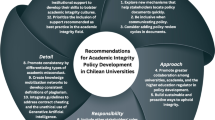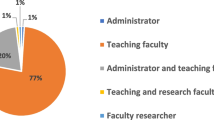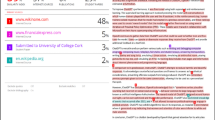Abstract
This study presents a corpus analysis of academic integrity policies from Higher Education Institutions (HEIs) worldwide, exploring how they address the issues posed by technological threats, such as Automated Paraphrasing Tools and generative-artificial intelligence tools, such as ChatGPT. The analysis of 142 policies conducted in November and December 2022, and May 2023 reveals a gap regarding the mention of AI and associated technologies in the available academic integrity policies. Despite the growing prevalence of these tools in the 6-month period since the release of ChatGPT, no HEIs had produced revised academic integrity policies. Content analysis of 53 guidance documents produced by HEIs suggests an overall positive focus of Gen AI tools, yet advises caution. This study suggests a modification to Bretag et al.’s (Int J Educ Integr 7, 2011) exemplary academic integrity model, introducing “Technological Explicitness” — emphasizing the need to include explicit guidelines about new technologies in academic integrity policies. These results underscore the urgent need for HEIs to revise their academic integrity policies, considering the evolving landscape of AI and its implications for academic integrity. This paper argues for a multifaceted approach to deal with the issues of integrating technology, education, policy reform, and assessment restructuring to navigate these challenges while upholding academic integrity.
Similar content being viewed by others
References
Abd-Elaal, E.-S., Gamage, S.H., and Mills, J.E. (2022) ‘Assisting academics to identify computer generated writing’, European Journal of Engineering Education 1–21. https://doi.org/10.1080/03043797.2022.2046709
Anderson, R. (2007) ‘Thematic content analysis (TCA)’, Descriptive presentation of qualitative data, 1–4.
Anohina-Naumeca, A., Tauginienė, L. and Odineca, T. (2018) ‘Academic integrity policies of Baltic state-financed universities in online public spaces’,International Journal for Educational Integrity, 14(1): 1–14. https://doi.org/10.1007/s40979-018-0031-z
Baker, P. (2004) ‘Querying keywords questions of difference, frequency, and sense in keywords analysis’, Journal of English Linguistics 32: 346–359. https://doi.org/10.1177/0075424204269894
Baker, P. (2006) Using corpora in discourse analysis. London: A&C Black.
Belter, R. W. and du Pré, A. (2009) ‘A strategy to reduce plagiarism in an undergraduate course’, Teaching of Psychology 36(4): 257–261. https://doi.org/10.1080/00986280903173165
Biderman, S. and Raff, E. (2022) ‘Fooling MOSS detection with pretrained language models’, ar**v https://doi.org/10.48550/ar**v.2201.07406
Bretag, T., Mahmud, S., Wallace, M., Walker, R., James, C. and Green, M., et al. (2011) ‘Core elements of exemplary academic integrity policy in Australian higher education’, International Journal for Educational Integrity 7(2). https://doi.org/10.21913/IJEI.v7i2.759
Brown, S. (2005) ‘Assessment for learning’,Learning and teaching in Higher Education (1), 81–89.
Brown, S. and Glasner, A. (1999) Assessment matters in higher education: choosing and using diverse approaches. UK: McGraw-Hill Education.
Chakraborty, S., Bedi, A.S., Zhu, S., An, B., Manocha, D. and Huang, F. (2023) ‘On the possibilities of AI-generated text detection’, ar**v. https://doi.org/10.48550/ar**v.2304.04736
Christ, M., Gunn, S. and Zamir, O. (2023) Undetectable watermarks for language models. https://eprint.iacr.org/2023/763. Accessed 6 June 2023.
Cotton, D.R., Cotton, P.A. and Shipway, J.R. (2023) ‘Chatting and cheating: ensuring academic integrity in the era of ChatGPT’, Innovations in Education and Teaching International 1–12. https://doi.org/10.1080/14703297.2023.2190148
Crawford, J., Cowling, M. and Allen, K.-A. (2023) ‘Leadership is needed for ethical ChatGPT: character, assessment, and learning using artificial intelligence (AI)’,Journal of University Teaching & Learning Practice 20(3): 02.
Create and search a text corpus | Sketch Engine. (2016) https://www.sketchengine.eu/. Accessed 12 December 2022
Crook, C. and Nixon, E. (2021) ‘How internet essay mill websites portray the student experience of higher education’, The Internet and Higher Education 48: 100775. https://doi.org/10.1016/j.iheduc.2020.100775
Curtis, G.J. (2022) Trends in plagiarism and cheating prevalence: 1990–2020 and beyond, in D. Rettinger, T. Bertram Gallant (eds.) Cheating academic integrity. Jossey-Bass, pp. 11–44. https://www.wiley.com/en-au/Cheating+Academic+Integrity%3A+Lessons+from+30+Years+of+Research-p-9781119868170. Accessed 18 November 2022.
Curtis, G.J. and Vardanega, L. (2016) ‘Is plagiarism changing over time? A 10-year time-lag study with three points of measurement’, Higher Education Research & Development, 35(6), 1167–1179. https://doi.org/10.1080/07294360.2016.1161602
Darling-Hammond, L. and Snyder, J. (2000) ‘Authentic assessment of teaching in context’, Teaching and teacher education 16(5–6): 523–545.
Dawson, M.M. and Overfield J.A. (2006) ‘Plagiarism: Do students know what it is?’, Bioscience Education 8(1): 1–15. https://doi.org/10.3108/beej.8.1
Dinneen, C. (2021) ‘Students’ use of digital translation and paraphrasing tools in written assignments on direct entry English programs’,English Australia Journal 37(1): 40–51. https://doi.org/10.3316/informit.748262877947586
Eaton, S.E. (2017). ‘Comparative analysis of institutional policy definitions of plagiarism: a pan-Canadian university study’, Interchange 48(3): 271–281. https://doi.org/10.1007/s10780-017-9300-7
Eaton, S.E., Vogt, L., Seeland, J. and Stoesz, B.M. (2023) Academic integrity policy analysis of Alberta and Manitoba colleges. https://hdl.handle.net/1880/116575. Accessed 6 June 2023.
Foltýnek, T. and Glendinning, I. (2015) ‘Impact of policies for plagiarism in higher education across Europe: results of the project’, Acta Universitatis Agriculturae et Silviculturae Mendelianae Brunensis 63(1): 207–216. https://doi.org/10.11118/actaun201563010207
Freake, R., Gentil, G. and Sheyholislami, J. (2011) ‘A bilingual corpus-assisted discourse study of the construction of nationhood and belonging in Quebec’, Discourse & Society 22(1): 21–47.
Fröhling, L. and Zubiaga, A. (2021) ‘Feature-based detection of automated language models: tackling GPT-2, GPT-3 and Grover’, PeerJ Computer Science 7, e443. https://doi.org/10.7717/peerj-cs.443
Furze, L. (2023). The AI assessment scale: from no AI to full AI – Leon Furze. Blog. https://leonfurze.com/2023/04/29/the-ai-assessment-scale-from-no-ai-to-full-ai/. Accessed 6 June 2023.
Gašević, D., Tsai, Y.-S. and Drachsler, H. (2022) ‘Learning analytics in higher education – stakeholders, strategy and scale’, The Internet and Higher Education 52: 100833. https://doi.org/10.1016/j.iheduc.2021.100833
Glendinning, I. (2013) Comparison of policies for academic integrity in higher education across the European Union. Available at: https://ketlib.lib.unipi.gr/xmlui/bitstream/handle/ket/814/Comparison%20of%20policies%20for%20Academic%20Integrity%20in%20Higher%20Education%20across%20the%20European%20Union.pdf?sequenc
Glendinning, I., Foltýnek, T., Dlabolová, D. and Linkeschová, D. (2017) Exploring issues challenging academic integrity in South East Europe. Plagiarism across Europe and Beyond 2017-Conference Proceedings, pp. 132–146. https://academicintegrity.eu/conference/proceedings/2017/Glendinning_Exploring.pdf
Gunser, V.E., Gottschling, S., Brucker, B., Richter, S. and Gerjets, P. (2021) Can users distinguish narrative texts written by an artificial intelligence writing tool from purely human text?, in International Conference on Human-Computer Interaction. New York: Springer, pp. 520–527. https://doi.org/10.1007/978-3-030-78635-9_67
ICAI. (n.d.). Our member institutions. https://academicintegrity.org/about/our-member-institutions?force=1. Accessed 7 June 2023.
Kaktiņš, L. (2014) ‘Appraising plagiarism policies of Australian universities’,Text & Talk 34(2), 117–141. https://doi.org/10.1515/text-2013-0040
Kennedy, G. (2014) An introduction to corpus linguistics. Oxfordshire: Routledge.
Kleinheksel, A.J., Rockich-Winston, N., Tawfik, H., & Wyatt, T.R. (2020) ‘Demystifying content analysis’, American Journal of Pharmaceutical Education, 84(1): 7113. https://doi.org/10.5688/ajpe7113
Köbis, N., & Mossink, L.D. (2021) ‘Artificial intelligence versus Maya Angelou: experimental evidence that people cannot differentiate AI-generated from human-written poetry’, Computers in Human Behavior 114: 106553. https://doi.org/10.1016/j.chb.2020.106553
Kumar, R., Mindzak, M., Eaton, S.E. and Morrison, R. (2022) AI & AI: exploring the contemporary intersections of artificial intelligence and academic integrity, in Presented at the Canadian Society for the Study of Higher Education Annual Conference, Online: Werklund School of Education. https://tinyurl.com/ycknz8fd
Kyngäs, H. (2020) Inductive content analysis, in H. Kyngäs, K. Mikkonen, M. Kääriäinen (eds.) The Application of Content Analysis in Nursing Science Research. Cham: Springer International Publishing, pp. 13–21. https://doi.org/10.1007/978-3-030-30199-6_2
Lancaster, T. (2023) ‘Artificial intelligence, text generation tools and ChatGPT – does digital watermarking offer a solution?’, International Journal for Educational Integrity 19(1): 1–14. https://doi.org/10.1007/s40979-023-00131-6
Liang, W., Yuksekgonul, M., Mao, Y., Wu, E. and Zou, J. (2023) ‘GPT detectors are biased against non-native English writers’, ar**v http://arxiv.org/abs/2304.02819. Accessed 12 May 2023.
Mahmud, S. and Bretag, T. (2014) ‘Fostering integrity in postgraduate research: an evidence-based policy and support framework’, Accountability in Research 21(2): 122–137. https://doi.org/10.1080/08989621.2014.847668
McCabe, D.L., Trevino, L.K. and Butterfield, K.D. (1999) ‘Academic integrity in honor code and non-honor code environments’,The Journal of Higher Education 70(2): 211–234. https://doi.org/10.1080/00221546.1999.11780762
Miron, J., McKenzie, A., Eaton, S.E., Stoesz, B., Thacker, E., Devereaux, L., et al. (2021) ‘Academic integrity policy analysis of publicly-funded universities in Ontario, Canada: a focus on contract cheating’, Canadian Journal of Educational Administration and Policy (197): 62–75. https://journalhosting.ucalgary.ca/index.php/cjeap/article/view/72082. Accessed 1 December 2022.
Möller, A. (2022) ‘An analysis of university academic integrity policies in New Zealand’, Journal of Further and Higher Education 47(3): 338–350. https://doi.org/10.1080/0309877X.2022.2130195
Morley, J. and Partington, A. (2009) ‘A few frequently asked questions about semantic—or evaluative—prosody’, International Journal of Corpus Linguistics 14(2): 139–158.
Nolan, B. and Ghosh, S. (2023) ChatGPT was a black swan event. Business Insider. https://www.businessinsider.com/chatgpt-changed-everything-and-was-a-black-swan-event-2023-5. Accessed 31 May 2023.
OpenAI (2022) ChatGPT: optimizing language models for dialogue. OpenAI. https://openai.com/blog/chatgpt/. Accessed 21 December 2022.
OpenAi. (n.d.). DALL·E 2. DALL·E 2. https://openai.com/dall-e-2/. Accessed 25 November 2022.
Perkins, M. (2023) ‘Academic Integrity considerations of AI large language models in the post-pandemic era: ChatGPT and beyond’, Journal of University Teaching & Learning Practice 20(2). https://doi.org/10.53761/1.20.02.07
Perkins, M., Gezgin, U.B. and Roe, J. (2020) ‘Reducing plagiarism through academic misconduct education’, International Journal for Educational Integrity 16(1): 3. https://doi.org/10.1007/s40979-020-00052-8
Perkins, M., Roe, J., Postma, D., McGaughran, J. and Hickerson, D. (2023) ‘Game of tones: faculty detection of GPT-4 generated content in university assessments’, ar**v. https://doi.org/10.48550/ar**v.2305.18081
QS World University Rankings. (n.d.) QS quacquarelli symonds. https://support.qs.com/hc/en-gb/articles/4405955370898-QS-World-University-Rankings. Accessed 23 December 2022.
Rahman, M.M. and Watanobe, Y. (2023) ‘ChatGPT for education and research: opportunities, threats, and strategies’, Applied Sciences 13(9): 5783. https://doi.org/10.3390/app13095783
Ramzan, M., Munir, M.A., Siddique, N. and Asif, M. (2012) ‘Awareness about plagiarism amongst university students in Pakistan’, Higher Education 64(1): 73–84. https://doi.org/10.1007/s10734-011-9481-4
Roe, J. (2022) ‘Reconceptualizing academic dishonesty as a struggle for intersubjective recognition: a new theoretical model’,Humanities and Social Sciences Communications 9(1): 1–7. https://doi.org/10.1057/s41599-022-01182-9
Roe, J. and Perkins, M. (2022) ‘What are automated paraphrasing tools and how do we address them? A review of a growing threat to academic integrity’,International Journal for Educational Integrity 18(1): 1–10. https://doi.org/10.1007/s40979-022-00109-w
Rogerson, A.M. and McCarthy, G. (2017) ‘Using internet based paraphrasing tools: original work, patchwriting or facilitated plagiarism?’, International Journal for Educational Integrity 13(1): 2. https://doi.org/10.1007/s40979-016-0013-y
Roig, M. (1997) ‘Can undergraduate students determine whether text has been plagiarized?’, The Psychological Record, 47(1): 113–122. https://doi.org/10.1007/BF03395215
Roig, M. (1999) ‘When college students’ attempts at paraphrasing become instances of potential plagiarism’, Psychological Reports 84(3): 973–982. https://doi.org/10.2466/pr0.1999.84.3.973
Roig, M. (2001) ‘Plagiarism and paraphrasing criteria of college and university professors’, Ethics & Behavior 11(3): 307–323. https://doi.org/10.1207/S15327019EB1103_8
Rudolph, J., Tan, S. and Tan, S. (2023) ‘ChatGPT: bullshit spewer or the end of traditional assessments in higher education?’, Journal of Applied Learning and Teaching 6(1). https://doi.org/10.37074/jalt.2023.6.1.9
Sadasivan, V.S., Kumar, A., Balasubramanian, S., Wang, W. and Feizi, S. (2023) ‘Can AI-generated text be reliably detected?’, ar**v. https://doi.org/10.48550/ar**v.2303.11156
SEEPPAI. (2017) South east European project on policies for academic integrity: final report. http://www.plagiarism.cz/seeppai/Final-report_SEEPPAI.pdf. Accessed 2 December 2022.
Sketch Engine. (2016) ‘Create and search a text corpus | Sketch engine’, https://www.sketchengine.eu/. Accessed 7 June 2023.
Stoesz, B.M. and Eaton, S.E. (2022) ‘Academic integrity policies of publicly funded universities in western Canada’, Educational Policy 36(6): 1529–1548. https://doi.org/10.1177/0895904820983032
Stoesz, B.M., Eaton, S.E., Miron, J. and Thacker, E.J. (2019) ‘Academic integrity and contract cheating policy analysis of colleges in Ontario, Canada’,International Journal for Educational Integrity, 15(1): 1–18. https://doi.org/10.1007/s40979-019-0042-4
Strzelecki, A. (2023) ‘To use or not to use ChatGPT in higher education? A study of students’ acceptance and use of technology’, Interactive Learning Environments 0(0), 1–14. https://doi.org/10.1080/10494820.2023.2209881
Sullivan, M., Kelly, A. and McLaughlan, P. (2023) ‘ChatGPT in higher education: Considerations for academic integrity and student learning’, Journal of Applied Learning and Teaching 6(1).
Turnitin.com. (n.d.) ‘AI writing detection frequently asked questions’, https://www.turnitin.com/products/features/ai-writing-detection/faq. Accessed 28 May 2023.
Uzun, L. (2023) ‘ChatGPT and academic integrity concerns: detecting artificial intelligence generated content’, Language Education and Technology 3(1). http://www.langedutech.com/letjournal/index.php/let/article/view/49. Accessed 29 May 2023.
Wahle, J.P., Ruas, T., Kirstein, F. and Gipp, B. (2022) ‘How large language models are transforming machine-paraphrased plagiarism’, ar**v preprint ar**v:2210.03568. https://arxiv.org/pdf/2210.03568.pdf
Wahle, J.P., Ruas, T., Meuschke, N. and Gipp, B. (2021) Are neural language models good plagiarists? A benchmark for neural paraphrase detection, in 2021 ACM/IEEE Joint Conference on Digital Libraries (JCDL). IEEE, pp. 226–229. https://doi.org/10.1109/JCDL52503.2021.00065
Warn, J. (2006) ‘Plagiarism software: no magic bullet!’, Higher Education Research & Development 25(2): 195–208. https://doi.org/10.1080/07294360600610438
Wilder, N., Weßels, D., Gröpler, J., Klein, A. and Mundorf, M. (2021) Who is responsible for integrity in the age of artificial intelligence? An analysis using the example of academic writing, in European Conference on Academic Integrity and Plagiarism 2021. Mendel University in Brno, pp. 179–181. https://tinyurl.com/2s4r5dyr
Wiliam, D. (2011). ‘What is assessment for learning?’, Studies in Educational Evaluation 37(1): 3–14.
Funding
No funding was received for this study.
Author information
Authors and Affiliations
Corresponding author
Ethics declarations
Conflict of interest
The authors declare that they have no conflicts of interest.
Generative-AI tool usage disclaimer
The production of this manuscript was supported with the use of the GPT-4 LLM (accessed through ChatGPT) for draft text production. The authors reviewed all output and take full responsibility for the accuracy of the content presented.
Additional information
Publisher's Note
Springer Nature remains neutral with regard to jurisdictional claims in published maps and institutional affiliations.
Rights and permissions
Springer Nature or its licensor (e.g. a society or other partner) holds exclusive rights to this article under a publishing agreement with the author(s) or other rightsholder(s); author self-archiving of the accepted manuscript version of this article is solely governed by the terms of such publishing agreement and applicable law.
About this article
Cite this article
Perkins, M., Roe, J. Decoding Academic Integrity Policies: A Corpus Linguistics Investigation of AI and Other Technological Threats. High Educ Policy (2023). https://doi.org/10.1057/s41307-023-00323-2
Published:
DOI: https://doi.org/10.1057/s41307-023-00323-2




